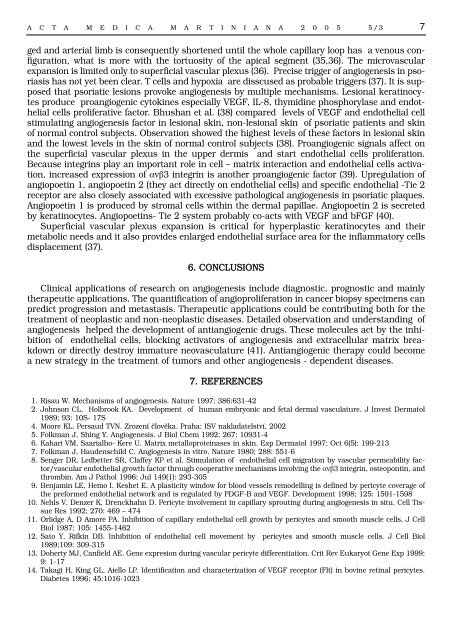MAKETA 5/3
MAKETA 5/3
MAKETA 5/3
Create successful ePaper yourself
Turn your PDF publications into a flip-book with our unique Google optimized e-Paper software.
A C T A M E D I C A M A R T I N I A N A 2 0 0 5 5/3 7<br />
ged and arterial limb is consequently shortened until the whole capillary loop has a venous configuration,<br />
what is more with the tortuosity of the apical segment (35,36). The microvascular<br />
expansion is limited only to superficial vascular plexus (36). Precise trigger of angiogenesis in psoriasis<br />
has not yet been clear. T cells and hypoxia are disscused as probable triggers (37). It is supposed<br />
that psoriatic lesions provoke angiogenesis by multiple mechanisms. Lesional keratinocytes<br />
produce proangiogenic cytokines especially VEGF, IL-8, thymidine phosphorylase and endothelial<br />
cells proliferative factor. Bhushan et al. (38) compared levels of VEGF and endothelial cell<br />
stimulating angiogenesis factor in lesional skin, non-lesional skin of psoriatic patients and skin<br />
of normal control subjects. Observation showed the highest levels of these factors in lesional skin<br />
and the lowest levels in the skin of normal control subjects (38). Proangiogenic signals affect on<br />
the superficial vascular plexus in the upper dermis and start endothelial cells proliferation.<br />
Because integrins play an important role in cell – matrix interaction and endothelial cells activation,<br />
increased expression of αvβ3 integrin is another proangiogenic factor (39). Upregulation of<br />
angiopoetin 1, angiopoetin 2 (they act directly on endothelial cells) and specific endothelial -Tie 2<br />
receptor are also closely associated with excessive pathological angiogenesis in psoriatic plaques.<br />
Angiopoetin 1 is produced by stromal cells within the dermal papillae. Angiopoetin 2 is secreted<br />
by keratinocytes. Angiopoetins- Tie 2 system probably co-acts with VEGF and bFGF (40).<br />
Superficial vascular plexus expansion is critical for hyperplastic keratinocytes and their<br />
metabolic needs and it also provides enlarged endothelial surface area for the inflammatory cells<br />
displacement (37).<br />
6. CONCLUSIONS<br />
Clinical applications of research on angiogenesis include diagnostic, prognostic and mainly<br />
therapeutic applications. The quantification of angioproliferation in cancer biopsy specimens can<br />
predict progression and metastasis. Therapeutic applications could be contributing both for the<br />
treatment of neoplastic and non-neoplastic diseases. Detailed observation and understanding of<br />
angiogenesis helped the development of antiangiogenic drugs. These molecules act by the inhibition<br />
of endothelial cells, blocking activators of angiogenesis and extracellular matrix breakdown<br />
or directly destroy immature neovasculature (41). Antiangiogenic therapy could become<br />
a new strategy in the treatment of tumors and other angiogenesis - dependent diseases.<br />
7. REFERENCES<br />
1. Risau W. Mechanisms of angiogenesis. Nature 1997; 386:631-42<br />
2. Johnson CL, Holbrook KA. Development of human embryonic and fetal dermal vasculature. J Invest Dermatol<br />
1989; 93: 10S- 17S<br />
4. Moore KL, Persaud TVN. Zrození člověka. Praha: ISV nakladatelství, 2002<br />
5. Folkman J, Shing Y. Angiogenesis. J Biol Chem 1992; 267: 10931-4<br />
6. Kahari VM, Saarialho- Kere U. Matrix metalloproteinases in skin. Exp Dermatol 1997; Oct 6(5): 199-213<br />
7. Folkman J, Haudenschild C. Angiogenesis in vitro. Nature 1980; 288: 551-6<br />
8. Senger DR, Ledbetter SR, Claffey KP et al. Stimulation of endothelial cell migration by vascular permeability factor/vascular<br />
endothelial growth factor through cooperative mechanisms involving the αvβ3 integrin, osteopontin, and<br />
thrombin. Am J Pathol 1996; Jul 149(1): 293-305<br />
9. Benjamin LE, Hemo I, Keshet E. A plasticity window for blood vessels remodelling is defined by pericyte coverage of<br />
the preformed endothelial network and is regulated by PDGF-B and VEGF. Development 1998; 125: 1591-1598<br />
10. Nehls V, Denzer K, Drenckhahn D. Pericyte involvement in capillary sprouting during angiogenesis in situ. Cell Tissue<br />
Res 1992; 270: 469 – 474<br />
11. Orlidge A, D Amore PA. Inhibition of capillary endothelial cell growth by pericytes and smooth muscle cells. J Cell<br />
Biol 1987; 105: 1455-1462<br />
12. Sato Y, Rifkin DB. Inhibition of endothelial cell movement by pericytes and smooth muscle cells. J Cell Biol<br />
1989;109: 309-315<br />
13. Doherty MJ, Canfield AE. Gene expresion during vascular pericyte differentiation. Crit Rev Eukaryot Gene Exp 1999;<br />
9: 1-17<br />
14. Takagi H, King GL, Aiello LP. Identification and characterization of VEGF receptor (Flt) in bovine retinal pericytes.<br />
Diabetes 1996; 45:1016-1023
















